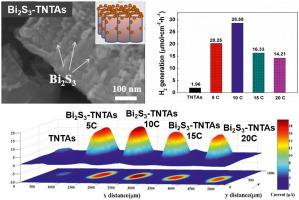International Journal of Hydrogen Energy ( IF 8.1 ) Pub Date : 2020-09-15 , DOI: 10.1016/j.ijhydene.2020.08.258 Zhi Wu , Ding Yuan , Sheng Lin , Wenxi Guo , Dongping Zhan , Lan Sun , Changjian Lin

|
Constructing heterosystems by sensitizing a wide band gap semiconductor with a narrow band gap semiconductor is an effective way to improve photocatalytic performance. Bismuth sulfide (Bi2S3) has a direct band gap of 1.38 eV and shows great potential in capturing visible light, which makes it a good candidate for photocatatlytic applications. In this work, Bi2S3 nanoparticles were efficiently deposited on TiO2 nanotube arrays (Bi2S3-TNTAs) by sequential chemical bath deposition (CBD) method to enhance visible light response of the photocatalytic system. Notably, a high-throughput screening method of scanning photoelectrochemical microscopy (SPECM) was exploited to evaluate photoelectrochemical response of the as-prepared composites and to find out the optimized photocatatlytic system. The effects of Bi2S3 nanoparticles on visible light absorption and photoelectrocatalytic hydrogen production rate of the TiO2-system were investigated in detail. When adopted as photoanode, the optimized heteroelectrode exhibited a more than 13-fold enhancement in hydrogen production rate. The result of electrochemical impedance spectroscopy (EIS) and photoluminescence (PL) shows that photo-generated charges excited under visible light in Bi2S3-TNTAs composites are efficiently separated, which gives rise to the superior photoelectrocatalytic performance of the Bi2S3-TNTAs photoanodes.
中文翻译:

Bi 2 S 3 -TiO 2纳米管阵列在可见光照射下异质结构的光电催化活性增强
通过用窄带隙半导体敏化宽带隙半导体来构造异质体系是提高光催化性能的有效方法。硫化铋(Bi 2 S 3)的直接带隙为1.38 eV,在捕获可见光方面显示出巨大的潜力,这使其成为光催化应用的良好候选者。在这项工作中,Bi 2 S 3纳米颗粒被有效地沉积在TiO 2纳米管阵列(Bi 2 S 3-TNTAs)通过顺序化学浴沉积(CBD)方法来增强光催化系统的可见光响应。值得注意的是,采用了一种高通量的扫描光电化学显微镜(SPECM)筛选方法来评估所制备复合材料的光电化学响应,并找到优化的光催化体系。Bi 2 S 3纳米颗粒对TiO 2可见光吸收和光电催化制氢速率的影响系统进行了详细调查。当用作光阳极时,优化的杂电极在氢气产生速率方面显示出超过13倍的增强。电化学阻抗谱(EIS)和光致发光(PL)的结果表明,Bi 2 S 3 -TNTAs复合材料在可见光下激发的光生电荷被有效分离,从而产生了Bi 2 S 3优异的光电催化性能。-TNTAs光阳极。











































 京公网安备 11010802027423号
京公网安备 11010802027423号